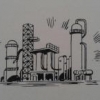Hi,
I am working a project on condensate splitter which have 6 products LPG, light naphtha, heavy naphtha, Kerosene, heavy distillate, Atmospheric Residue. I have feed assay aslo with me,
I want to know how can I choose D86 cut point for thsese product. While searching the literature I found different cut point for same product in different books.
What would be the right approach? Is all product for condensate splitter being used for blending?
Please guide me.
Thanks, Please attach any document if you have related to condensate splitter topic.
Regards.

 FB
FB













